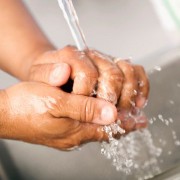 Photo: Getty Images
Photo: Getty Images
I’ll bet I’m not the first person who was relieved when public facilities started introducing hands-free, sensor-enabled water faucets. "Finally!" I thought, "some wise person has implemented an even more sanitary option for washing hands in public restrooms."
Does it get much better than that in terms of feeling hands-free and sanitary? One would think not.
Unfortunately, those aren’t the findings of Johns Hopkins Hospital. They found quite the opposite instead. Hands-free faucets bred more bacteria and were overall a less sanitary option than old-style fixtures with separate handles for hot and cold water in their hospital.
Johns Hopkins researchers identified Legionella, one of the most common and hazardous water-borne bacteria in hospitals, growing in 50 percent of cultured water samples from 20 electronic-eye faucets in or near patient rooms on three different inpatient units, but in only 15 percent of water cultures from 20 traditional, manual faucets in the same patient care areas, according to the study by Johns Hopkins Medical Institutions.
Weekly water culture results also showed half the amount of bacterial growth of any kind in the manual faucets than in the electronic models, despite the high-tech faucets’ ability to cut daily water consumption by well over half.
While the precise reasons for the higher bacterial growth in the electronic faucets still need clarification, the researchers say it appears that standard hospital water disinfection methods, which complement treatments by public utilities, did not work well on the complex valve components of the newer faucets. They suspect that the valves simply offer additional surfaces for bacteria to become trapped and grow.
The Johns Hopkins researchers will present their findings at the annual meeting of the Society for Health Care Epidemiology (SHEA) in Dallas on April 2, 2011.
"Newer is not necessarily better when it comes to infection control in hospitals, especially when it comes to warding off potential hazards from water-borne bacteria, such as Legionella species," said senior study investigator and infectious disease specialist Lisa Maragakis, M.D., M.P.H.
"New devices, even faucets, however well intentioned in their make-up and purpose, have the potential for unintended consequences, which is why constant surveillance is needed," said Maragakis, director of hospital epidemiology and infection control at Hopkins Hospital and an assistant professor at the Johns Hopkins University School of Medicine.
Johns Hopkins facilities engineers removed all 20 newer faucets from patient care areas and replaced them with manual types.
Researchers said their next steps are to work with manufacturers of electronic and manual faucets to help remedy their flaws and to design components that can be cleaned more easily and save water. They have also notified infection control staff at other hospitals of their latest findings.
While this study relates specifically to Johns Hopkins Hospital and has other variables – such as the hospital’s own water cleansing processes – it does make us stop and think "Just how sanitary are the hands-free faucets we use everyday?"
http://www.eurekalert.org/pub_releases/2011-03/jhmi-lhe032811.php
http://www.hopkinsmedicine.org/heic
http://www.shea-online.org/about/annual_meeting_overview.cfm





Add a CommentComments
There are no comments yet. Be the first one and get the conversation started!